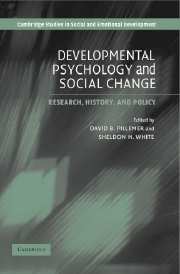Book contents
- Frontmatter
- Contents
- Preface
- List of Contributors
- Introduction: What Kind of Science Is Developmental Psychology?
- Part One The Developing Child: Global and Historical Perspectives
- Part Two Designing Child and Family Policies
- Part Three Designing Child Health Policies
- Part Four Designing Effective Learning Environments for Children and Adolescents
- 9 A Cultural/Historical View of Schooling in Human Development
- 10 The Rise of the American Nursery School: Laboratory for a Science of Child Development
- 11 Actualizing Potentials: Learning through Psychology's Recurrent Crises
- 12 The Rise of a Right-Wing Culture among German Youth: The Effects of Social Transformation, Identity Construction, and Context
- 13 Learning Potential Assessment: Where Is the Paradigm Shift?
- 14 Teaching as a Natural Cognitive Ability: Implications for Classroom Practice and Teacher Education
- Index
- References
9 - A Cultural/Historical View of Schooling in Human Development
Published online by Cambridge University Press: 03 December 2009
- Frontmatter
- Contents
- Preface
- List of Contributors
- Introduction: What Kind of Science Is Developmental Psychology?
- Part One The Developing Child: Global and Historical Perspectives
- Part Two Designing Child and Family Policies
- Part Three Designing Child Health Policies
- Part Four Designing Effective Learning Environments for Children and Adolescents
- 9 A Cultural/Historical View of Schooling in Human Development
- 10 The Rise of the American Nursery School: Laboratory for a Science of Child Development
- 11 Actualizing Potentials: Learning through Psychology's Recurrent Crises
- 12 The Rise of a Right-Wing Culture among German Youth: The Effects of Social Transformation, Identity Construction, and Context
- 13 Learning Potential Assessment: Where Is the Paradigm Shift?
- 14 Teaching as a Natural Cognitive Ability: Implications for Classroom Practice and Teacher Education
- Index
- References
Summary
In this paper we examine changing arrangements of human development that have accompanied societal shifts to mass, compulsory “Western” schooling. We draw attention to the often taken-for-granted role of schooling in children's lives once extensive schooling has become the childhood norm in their communities. To do so, we examine two cases, involving very different histories and current conditions. We first examine the life patterns associated with the growth of mass schooling across the past centuries for European-heritage families in the United States, integrating the work of historians who have described the process. Then we examine the phenomenon across three generations of Mayan families in Guatemala, using our own interviews and observations.
In the United States one can generally assume that if a child is 6 years old, she is in the first grade, or if a child is in the first grade, she is about 6 years old. As Irwin et al. (1978) put it, “In Western industrialized countries, going to school has the same inevitability for children that death and taxes have for their parents” (p. 415).
Although psychologists often identify developmental transitions in terms of children's ages, age indexes both biological maturation and changing roles in cultural institutions. As White (1975) has pointed out, age 5 to 7 years has for some centuries marked societal shifts in treatment of children, such as the standard onset of formal schooling in Europe and the United States.
- Type
- Chapter
- Information
- Developmental Psychology and Social ChangeResearch, History and Policy, pp. 225 - 263Publisher: Cambridge University PressPrint publication year: 2005
References
- 38
- Cited by

